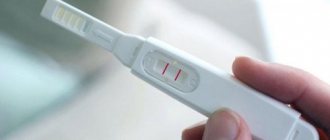How the test works
The test looks for a hormone called human chorionic gonadotropin (hCG). It is produced by a woman's body after fertilization. The substance is synthesized in the membrane of the fertilized egg, starting from the moment when the egg attaches to the uterus after fertilization. Since this happens 7 days after conception, pregnancy can be determined from this moment.
If the woman is not pregnant, hCG is also produced, but its concentration does not exceed 5 mIU/ml. When pregnancy occurs, the hormone levels increase rapidly. For example, after a week it reaches 10 mIU/ml, and a month after conception – 151,000 mIU/ml.
Accuracy check / My baby and I
Consultant: Nona Hovsepyan, consultant physician, Independent Laboratory INVITRO Text: Natalia Rubina
We, of course, understand that in a magazine like ours it’s already a little late to write about pregnancy tests. But very often visitors to the site krokha.ru have questions: “How can I tell if I’m pregnant? Can the test be wrong?
How it works?
All pregnancy tests operate on the same principle - they recognize a special hormone called human chorionic gonadotropin (hCG) in urine (tests for home use) or blood (laboratory tests). It is produced only during pregnancy. A non-pregnant woman simply cannot have it (more precisely, it can, but only in exceptional cases, which are discussed below). The amount of hCG in the body from the moment the fertilized egg attaches to the wall of the uterus doubles approximately every 2-3 days and reaches a maximum by 7 - 12 weeks of pregnancy. Its presence in the blood and urine can be detected until approximately the third week after birth.
When purchasing a pregnancy test, pay attention to its sensitivity. Typically, most tests have a sensitivity of 20-25 mIU/mL (international units per mL). They are able to recognize pregnancy only from the first day of missed menstruation. Whereas there are more sensitive (but also more expensive) tests (10 mIU/ml) that can determine pregnancy within 7-10 days from the moment of expected conception. And after a week of delay, pregnancy (if any) will be shown by any tests.
If you want to find out if you are pregnant as early and accurately as possible, it is better to go and have a blood test done at a antenatal clinic or a specialized laboratory. HCG appears in the blood faster than in the urine, so pregnancy can be determined even before the expected period (but not earlier than 7 days from the date of conception). A blood test can be qualitative (the answer will be: yes or no) and quantitative, when the analysis form will tell you the exact amount of hCG in your blood. It is better to do the second option, since then (by taking it several more times) it will be possible to monitor the dynamics of the development of pregnancy. Doing a dynamic test, in particular, is useful to recognize a pregnancy that has frozen in the early stages. If the embryo freezes in development, the hCG level stops growing, and the test will immediately show this. QUESTION ON THE SITE WWW.KROKHA.RU
Olga B. “On the second day of the delay, I took a test, and it showed two lines. But one of them is very weak. Am I pregnant? Nona Hovsepyan: Even if the second line is weak, but there, you are pregnant. However, if in doubt, re-test 3-4 days later. The level of hCG in the body will increase noticeably and the stripe will be much brighter. Can a test lie? All instructions say that pregnancy tests are 95-99% accurate. This means that there is a chance that the result will be incorrect. So, a false negative result is possible if:
• you performed the test too early and the level of hCG in the urine is still too low; ^ the test has expired (so carefully study the packaging before buying the test); • you performed the test incorrectly (although it is difficult to imagine that this is possible - everything is extremely simple there); • drinking too much liquid the day before the test can dilute the urine and reduce the concentration of hCG;
The test can also show a false positive result:
• if you are taking fertility drugs that contain hCG (usually in the form of injections); • HCG can appear in the body during hydatidiform mole, a disease associated with the pathology of the trophoblast (a temporary organ necessary for attachment of the embryo to the wall of the uterus). During hydatidiform mole, the trophoblast degenerates into a huge number of small bubbles. These bubbles occupy the entire uterine cavity and tend to grow rapidly. The main symptom of hydatidiform mole is bloody vaginal discharge due to delayed menstruation. To clarify the diagnosis, you need to see an obstetrician-gynecologist as soon as possible; • Normally, elevated hCG levels can be observed up to 3 weeks after premature birth or miscarriage. But a positive test result may also mean that remnants of the fertilized egg remain in the uterus. In order to find out, you need to do an ultrasound and, if necessary, curettage of the uterine cavity.
Cannot influence the result:
• kidney diseases; • taking contraceptive medications; • taking antibiotics; • drinking alcohol; • lactation.
What tests are there?
1. Strip tests (paper strips).
These are the simplest, cheapest and most common tests. The strip needs to be lowered for 10-20 seconds to a certain mark in a container with morning urine (it is the most concentrated). After this, place the test on a horizontal surface and evaluate the result after a few minutes. One line means you are not pregnant, two lines means you are pregnant.
2. Tablet tests.
They are designed in the same way as strip tests. Only the paper strip is placed in a plastic case. And the previously collected morning urine needs to be dropped into a special hole with the pipette included with the test. The result is also shown in the form of one or two stripes.
3. Jet tests.
Their convenience is that there is no need to collect urine anywhere—the test strip just needs to be placed under the stream. In this case, urine does not have to be morning. Inkjet tests are more sensitive. The result is assessed by one or two stripes.
4. Electronic tests.
They have a special strip - a sample receiver, which you can optionally lower into a container with urine or place under the stream. The result is read in 3 minutes. If “+” or the inscription “pregnant” appears on the test, you are pregnant, but if “-” or “not pregnant”, you are not.
5. Interactive tests.
Recently, a lot of so-called virtual or interactive tests have proliferated on the Internet. But there is not the slightest sense in believing them. At best, this is just a scam, at worst, it’s a way for scammers to make money. So, in the simplest tests, you are asked to place your finger on a square on the screen, and if after 2 minutes it turns red, you are pregnant, but if the square turns blue, you are not. The square turns red even if you don't touch the screen. Apparently this test is for those who have no doubt that they will soon become a mother. More complex tests ask you to answer a number of questions, including “Have you recently had unprotected sex?” and “Do you feel engorgement in your breasts?” As a result, it is proposed to receive a response after sending an SMS to a specific number.
Can a test detect an ectopic pregnancy?
If the fertilized egg has implanted outside the uterus, a regular pregnancy test will still be positive. However, such a pregnancy, as a rule, is terminated at 7-8 weeks, and this is accompanied by large blood loss and serious problems for the woman’s health. To avoid this, it is better to recognize and terminate an ectopic pregnancy in advance (it is impossible to save it).
The main symptoms of an ectopic pregnancy: with a positive pregnancy test, nagging pain in the lower abdomen and spotting appear. In this case, you need to get an ultrasound as soon as possible. With an ectopic pregnancy, there is no fertilized egg in the uterine cavity, but the doctor will notice the growth of the endometrium, as in a normal pregnancy.
If you belong to a risk group (adhesions, inflammation of the appendages, or have previously had an ectopic pregnancy), then it is better to conduct a high-quality pregnancy test using blood over time. During an ectopic pregnancy, the level of hCG in the blood is lower than during a normal pregnancy, and the test will immediately show this.
IT IS IMPORTANT!
Despite the fact that all women have different lengths of the menstrual cycle, the period after ovulation for all is 14 days, which means that by the beginning of the next cycle, pregnancy can already be determined, since implantation of the fertilized egg occurs approximately 6-7 days after conception.
FOLK WISDOM
When there were no pregnancy tests yet, our ancestors knew other ways to diagnose pregnancy.
Collect some urine in a jar and drop a drop of iodine into it. If the drop dissolves in urine, this indicates the absence of pregnancy. If the drop holds a large shape, the woman is pregnant.
In Ancient Greece, it was believed that a pregnant woman's iris became slightly darker.
Water the flowers in the flower bed with morning urine. If the flowers bloom very profusely after this, it means the woman is pregnant.
Take two onions and plant them in two pots. Write “yes” on one and “no” on the other. Water both bulbs with morning urine and wait until one of the sprouts sprouts. If the bow with the inscription “yes” is the first to “throw out an arrow,” this means that pregnancy has occurred.
Main types of pregnancy tests
Today, several types of tests have been developed with varying degrees of sensitivity. The study can be carried out in a clinical or home setting. So, in pharmacies you can buy the following types of tests:
- Strip test (stip test) is the simplest type. Allows reliable diagnostics from the first day after the delay. It works simply and quickly - dip the strip into the urine and after a few minutes look at the result: 2 strips - “yes”, 1 strip - “no”. At the same time, the accuracy is low, and failures are often observed.
- Tablet test - the principle of operation is exactly the same. However, the accuracy is higher. This also affects the price - the tablet costs more than a regular strip.
- The inkjet test is a very reliable test, providing an accuracy of about 99.8%. The name is associated with the peculiarities of the study - the strip is placed under a stream of urine.
- A digital test is another precise type of research. It gives an almost instantaneous result, which is displayed on the screen of a digital device as a “+” (confirmation) or “-” (negation) icon. Along with this, the device calculates the gestational age. The only drawback of this type of test is the high price.
Can my test be positive for an ectopic or non-developing pregnancy?
Any progressive pregnancy is accompanied by the production of hCG, regardless of where it is localized - in the uterus, tube or anywhere else. Therefore, during an ectopic pregnancy, tests will certainly show a second line. True, sometimes it has a pale appearance due to the fact that the growth of hCG can be very slow. But there are cases when a pathological pregnancy is accompanied by almost normal dynamics of hormone growth.
If the pregnancy has stopped developing, the tests will still “draw” a second line - hCG is removed from the blood very slowly. Another type of non-developing pregnancy, anembryony, in which the embryo dies in the early stages of development, and the fertilized egg and placenta continue to grow, is also confirmed by positive tests. At the same time, hCG can double, as it should, and the strip becomes brighter every day.
When is the right time to take the test?
The earliest time for diagnosis is 8 days after the expected conception. At this point, you can only use a laboratory blood test, since all other methods will probably give an inaccurate result.
As for the pharmacy test, it is used a little later:
- 1-2 days after a missed period;
- 2 weeks after the expected conception.
However, it is not recommended to rush. The strips are most accurate 7 days after the delay. It is at this time that you can find out the correct result with a probability close to 100%.
When is early diagnosis carried out?
It is advisable to do early diagnosis if you had unprotected sexual intercourse on the 10-15th day of the cycle. If fertilization of the egg has occurred, after the embryo is fixed in the uterus, the woman may experience the first signs of pregnancy even before the delay.
Possible pregnancy symptoms:
- the breasts swell, the sensitivity of the mammary glands increases;
- taste preferences change;
- weakness and signs of a cold appear;
- the urge to urinate becomes more frequent;
- I am concerned about short-term pain in the lower abdomen.
If you conduct home diagnostics before your period is missed, the results of the first test cannot be considered reliable; repeat the procedure after 48-72 hours.
You can do the test at any time, but it is better to carry out the diagnosis in the morning, use the first portion of urine, collect it in a sterile container, and in the evening try not to drink a lot of liquid.
→ Learn more about the first signs of pregnancy before your period
How to use the test
The instructions are quite simple:
- Determine the timing of the analysis.
- Purchase a test and a clean jar for collecting urine from the pharmacy.
- Collect urine in the morning (it is at this time that the concentration of hCG is maximum).
- Immerse the strip for 15 seconds.
- Remove and place on a clean dish or other surface.
- Wait up to 5 minutes.
- Determine how many stripes are colored.
There may also be other instructions. For example, in the case of a jet test, the strip is not immersed in the collected urine, but is placed under the stream directly during emission. If the digital version is used, the strip is inserted into the device, which displays the results on a liquid crystal screen.
To interpret the results, you can use the following rules:
- If only one stripe is colored, pregnancy is not confirmed.
- If 2 stripes are colored, the fact of pregnancy has been established.
- If there are none, the test is expired or defective.
It may also turn out that the second strip is visible, but rather weakly. This indicates a low concentration of the hormone. Perhaps the test was done too early or it was not sensitive enough. There may be other reasons - chronic diseases, early miscarriage, recent abortion, taking drugs to enhance fertility.
In such cases, it is necessary to do another test, but not the next day, but after 2-3 days. If the second strip is faintly colored again, it is recommended to consult a doctor and perform an ultrasound of the uterus.
Additional Methods
In addition to rapid tests, there are other ways to diagnose pregnancy. A blood test for beta-hCG will help assess the correct course of pregnancy in the early stages. This type of analysis allows you to find the exact amount of the hormone in the patient’s blood and track the dynamics of its growth. A very slow increase in hCG indicates difficulties associated with the pathology of embryo development, and a very rapid increase indicates the likelihood of a multiple pregnancy. This is the most accurate way to determine pregnancy; it can be used to confirm the result of the test, which gives the highest, but still not one hundred percent, guarantee. And also, a blood test for beta-hCG will allow you to detect pregnancy at an extremely early stage, which is especially important when conceiving using IVF.
If the pregnancy test is positive, an urgent consultation with an obstetrician-gynecologist is required. Proper support of pregnancy from the first weeks is the key to the birth of a healthy baby. An express test is the fastest and most accurate method for diagnosing pregnancy in the early and very early stages. But if you do not want pregnancy, it is best to use modern methods of contraception.
Delay during menopause and breastfeeding
Delayed menstruation during menopause (after 40-45 years).
The first sign of the premenopausal period in all women is a delay in menstruation. This occurs due to a decrease in the concentration of sex hormones. Changes in the duration of the menstrual cycle can reach up to 90 days, while the discharge becomes scanty. Menstruation may not come for several months, but then the cycle is restored.
In women over 40 years of age, the ability to conceive decreases, but pregnancy in this case is still possible. The endometrium thickens at this age, which leads to delayed uterine bleeding. If a delay in menstruation occurs after 40 years, even with a negative test, you must make an appointment with a gynecologist and have an ultrasound done.
Delayed menstruation during breastfeeding.
When breastfeeding, menstruation usually does not occur (so-called lactational amenorrhea), but this does not mean that pregnancy is excluded. Hoping for lactation, a woman does not go to the gynecologist until the fetus begins to move. At this stage, abortion is already prohibited, although childbirth with a short interval is undesirable.
Could it be that there is a second line, but there is still no pregnancy?
Yes, this happens occasionally. HCG levels may increase in cysts and polycystic ovaries and other rare conditions. In other cases, a line on the test is a reliable sign of pregnancy. However, it should be remembered that the test “detects” not only a normal pregnancy, but also its pathological variations - ectopic and frozen pregnancy. Therefore, the next step for an anxious woman is to visit an obstetrician-gynecologist. In addition, sometimes a reagent may appear on the test - a pale, almost uncolored second line. If a woman observes a similar result, advise her to repeat the test after two days, preferably from a different manufacturer.
Which test is the most accurate? The one that is the most expensive?
When trying to determine the accuracy of a pregnancy test, it is better to look not at the price tag, but at the packaging. It indicates the sensitivity of the test: the higher it is, the sooner the test will be able to determine the content of hCG in the urine. Most often, the sensitivity of tests is 20–25 mIU/ml. For more “advanced” models, 10 mIU of hCG in 1 ml is sufficient for a positive response. At the same time, a more sensitive test strip costs much less than a less “fast” inkjet test. And the sensitivity of the most expensive electronic tests is most often the same as that of the “simples” (20–25 mIU/ml). The only difference between them is that the results are processed by a special program, and not by women, who can sometimes “see” the strip even on a crystal-white surface.
How to induce menstruation if you are late: more precisely, how to create big problems for yourself
It is technically possible to induce menstruation on your own, but gynecologists categorically prohibit doing this, because the reason for the delay is not clear and most often such amateur activity leads to severe bleeding, deterioration of the condition, increased inflammation, even peritonitis.
Most often on the Internet it is advised to induce menstruation as follows:
- Take a hot bath with water
. With high blood pressure, this method will lead to a hypertensive crisis. With vein thrombosis - vasodilation and hemorrhage. In the presence of blood clots, blood clot separation and embolism (blockage of a vessel by a blood clot) are guaranteed. - Take large doses of vitamin C.
Women suffering from stone formation in the bladder and kidneys and bladder (after 30 years everyone has this problem) after such vitaminization of the body can go to the hospital. It is also dangerous for pregnant women - a miscarriage will not happen, but it is difficult to say how such an acid attack will affect the fetus. This also includes advice to drink concentrated infusions of ginger and parsley. These medicinal plants contain a large dose of ascorbic acid and much more. - Strengthen your intimate life
. It is possible that menstruation may occur due to the rush of blood during sexual intercourse. But if there is some kind of pathology in the body, then it is better to identify it and cure it. The onset of menstruation will only delay a trip to the gynecologist for a month. Then everything will happen again. - Take medicinal tinctures
. Herbs that stimulate menstruation include: cornflower, oregano, rosehip, yarrow, nettle, elecampane and knotweed. Self-medication may result in hives. Do you want to walk around with red pimples and itch constantly? Go ahead - collect herbs! - Drink a decoction of onion peels
. Frankly disgusting. Whether it will help or not is unknown, but you are guaranteed disgusting sensations for the next day.
Gynecologists advise: if there was a delay, don’t risk it! Contact a good gynecologist, get examined, do an ultrasound. Modern gynecology easily and quickly diagnoses the causes of amenorrhea and eliminates it.
How to avoid an erroneous result
Unfortunately, even the most expensive and most sensitive test cannot guarantee 100% accuracy. When purchasing, you must carefully examine the packaging of the test - it must be undamaged, and the expiration date must be normal. Doctors recommend purchasing tests at a pharmacy, where there is a better chance that the storage conditions have been met.
You should also pay attention to the manufacturer. A test produced by a well-known, large manufacturer is less likely to be defective or of poor quality. The price of the test also plays a significant role - some cheap tests are made of low-quality materials, for example, the coloring substance under the influence of liquid can shift and give a false positive result.
To obtain a reliable result, you must strictly follow the rules for using the test. If you remove the test strip from the container with urine too quickly, it will not have time to soak well enough to show an accurate result. If you leave the test in the urine for a long time or immerse it above a certain level, the result may also be unreliable.








